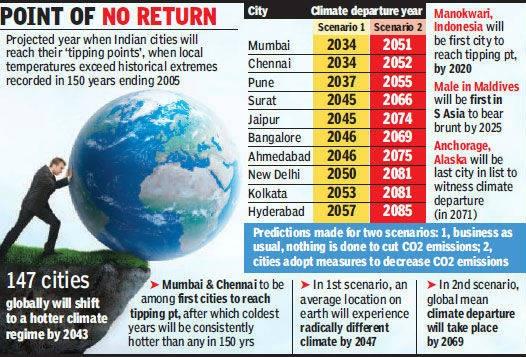October 11, 2013
NEW DELHI: Around 20 years from now, Mumbai and Chennai could routinely start witnessing temperatures hotter than the two cities have experienced in 150 years, an alarming new University of Hawaii study predicting the climate 'tipping points' of various cities around the world has warned.

October 11, 2013
NEW DELHI: Around 20 years from now, Mumbai and Chennai could routinely start witnessing temperatures hotter than the two cities have experienced in 150 years, an alarming new University of Hawaii study predicting the climate 'tipping points' of various cities around the world has warned.

By 2045, Pune, Surat, Jaipur, Bangalore and Ahmedabad would have joined the ranks of cities showing such climate departure, which means even the monthly dips in temperatures would be hotter than that experienced in 150 years (ending 2005), states the paper published in Nature on Wednesday.
The study, a massive new analysis of all climate models, says most cities around the world would have reached their climate tipping points by 2047 if no new steps to contain carbon dioxide emission are initiated.
The paper carries predictions for 10 Indian cities, saying Mumbai and Chennai will be the first to reach the 'point of no return' — as early as 2034 — in the "business as usual" scenario wherein the world makes no special efforts to cut emissions.
Even in the second scenario, where concerted efforts are made to cut emissions, Mumbai is predicted to reach its tipping point by 2051, followed by Chennai a year later. Delhi will follow suit by 2050 (in first scenario) or 2081 (in second scenario).
"The results shocked us. Regardless of the scenario, changes will be coming soon," said lead author Camilo Mora of the University of Hawaii. "Within my generation, whatever climate we were used to will be a thing of the past".
Other Indian cities, the study says, will only be delaying the inevitable by a few years. The list predicts Hyderabad would reach tipping point by 2057 or 2085 (under two different scenarios) and Kolkata by 2053 (or 2081).
The years mentioned against each city denotes the beginning of an entirely new — and hotter — climate regime for that city.

These predictions have come from an analysis of 39 climate models developed independently by 21 climate centres in 12 different countries. The Nature reported that Mora and his team of researchers from the University of Hawaii used those climate models to assemble projections on seven environmental variables, such as near-surface air temperature and precipitation, for the years 1860-2005.
"The researchers then ran simulations for the next 100 years to identify the years in which climate variables are predicted to exceed historical limits in various locations", said the report. The study — Projected Timing of Climate Departure from Recent Variability — is the first of its kind which pinpointed when global warming will become the norm in the world's major cities.
The complete global list of cities is available online at the University of Hawaii website. It shows that the Indonesian cities Manokwari will reach its tipping point as early as 2020 and Jakarta by 2029, whereas Maldives capital Male will reach there by 2025 in the business-as-usual scenario.
The statement also referred to the fact that countries first impacted by unprecedented climates are the ones with the least capacity to respond. Co-author Ryan Longman said, "Ironically, these are the countries that are least responsible for climate change in the first place".
Courtesy: TNN
















































































































